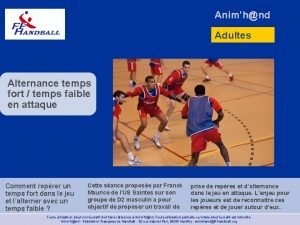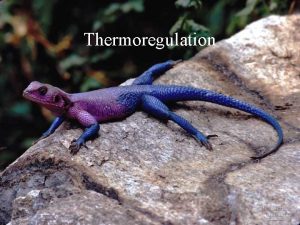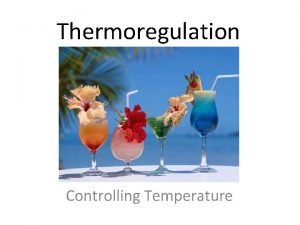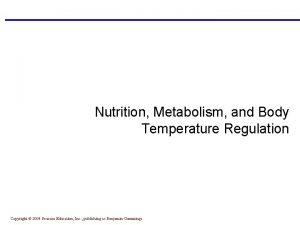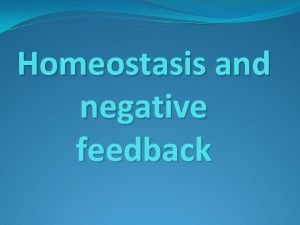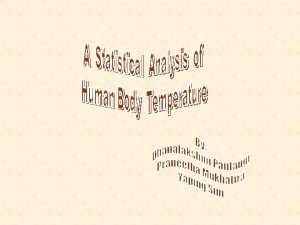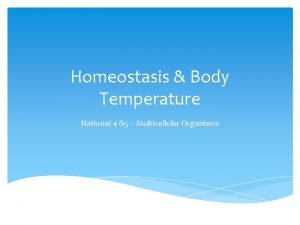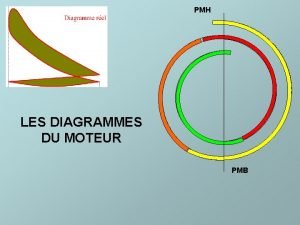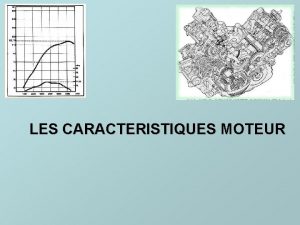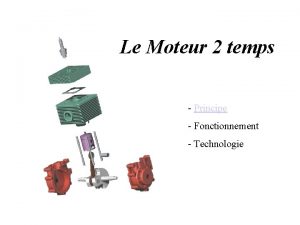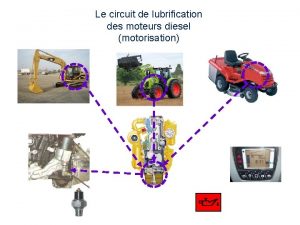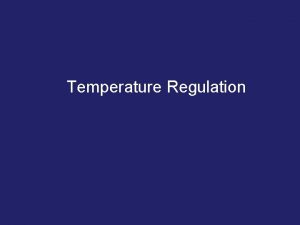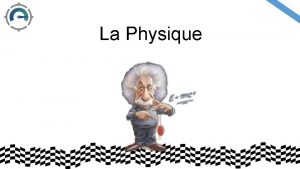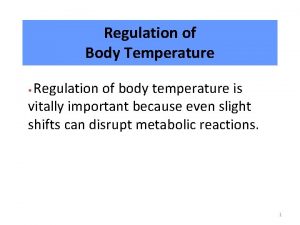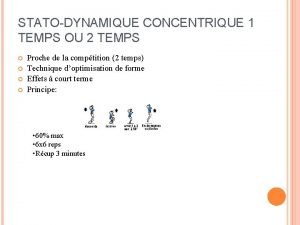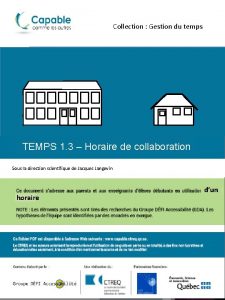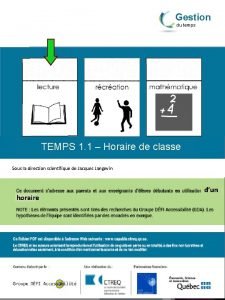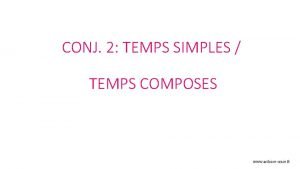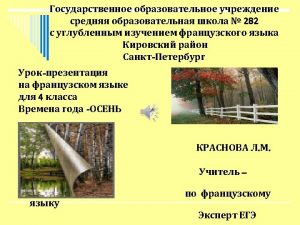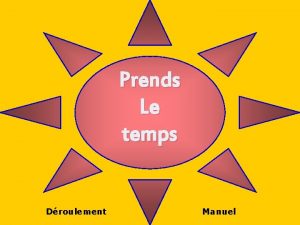Temperature Regulation Importance of Temperature Regulation core temps





























- Slides: 29

Temperature Regulation

Importance of Temperature Regulation • core temps above 41 C result in protein destruction • core temps above 45 C can result in death • core temps below 34 C result in slowed metabolism and impaired cardiac function

Steady State Temp. Regulation

Overview of Heat Balance • balance maintained by matching heat loss to heat gain • during exercise heat production is great, so must increase heat loss • blood flow is primary means of controlling temperature

Temperature Measurement • core temperature is best estimated by rectal thermometers – also tympanic or esophageal • skin temperature can be estimated by sampling various surfaces and averaging the values • note that there may be a large gradient between the core and skin temps

Modes of Heat Production

Heat Production • Voluntary - exercise • involuntary - shivering, biochemical (thyroxine, sympathetic hormones) • 20 - 30% efficiency producing work (80 % heat production)

Involuntary Heat Production • shivering - can increase heat production 5 x resting values • non-shivering thermogenesis – thyroxine – catecholamines (sympathetic hormones epinephrine and norepinephrine)

Heat Loss • • radiation conduction convection evaporation

Radiation • loss of heat via infrared rays • no physical contact involved between two surfaces or molecules • at rest 60 % of heat loss can occur via radiation • need temperature gradient, therefore on hot day can gain heat via radiation as well (sun, pavement etc. )

Conduction • requires physical contact between two surfaces • eg. Sitting on a cool surface, metal or concrete • minor contributor in most cases

Convection • form of conduction specific to either air or water molecules • eg. Fan blowing cool air onto the skin – warm air molecules are moved away from the body as cooler ones come into contact which in turn become warmed and are moved away by cooler ones ad infinitum • when swimming in cool water convection primary means of cooling

Evaporation • 25 % of heat loss at rest • during exercise primary means of heat loss • heat transferred to H 2 O molecules on skin – when H 2 O vaporizes, removes heat • dependent upon concentration gradient of H 2 O (vapor pressure) – during high humidity, H 2 O won’t evaporate (100% humidity in air there is virtually no concentration gradient for H 2 O on skin

Insert table 12. 1

Evaporation Example • running 30 C and 100 % humidity, skin temp 34 – vapor pressure on skin ~ 35 mm. Hg – vapor pressure in air ~ 32 mm. Hg • running 10 C and 50 % humidity, skin temp 30 – vapor pressure on skin ~ 32 mm. Hg – vapor pressure in air ~ 4 mm. Hg

Heat Exchange Mechanisms during Exercise

The Body’s Thermostat • Anterior hypothalamus - responds to increases in body heat • Posterior hypothalamus - responds to decreases in body heat • Thermostat set at 37 C

Increases in Temperature • Receptors on skin first sense changes – receptors also located in spinal cord and hypothalamus respond to core temp changes • Stimulates sweat glands - increases evaporation • Increases skin blood flow - vasodilation

Responses to Heat

Decreases in Temperature • Vasoconstriction of peripheral vessels – reduces heat loss to surroundings • Involuntary shivering – increases metabolic heat production • Piloerection - ineffective • Increased thyroxine production • Increased sympathetic hormone production – nonshivering thermogenesis

Responses to Cold

Changes in Heat Production and Loss during Exercise

Take Home Message • During exercise, evaporation is the most important method of heat loss • Elevated core temp during steady state exercise is not a new “set point”, but a balance between heat production and loss which is inadequate to reduce temp to set point

• Metabolic heat production increases in proportion to the exercise intensity • Convective and radiative heat loss do not increase with intensity as temp gradient between body and environment does not change significantly

Hyperthermia • Increased core temperature to the point that physiological functions are impaired • Contributing factors – dehydration – electrolyte loss – failure of cooling mechanisms to match heat production

Exercise in Hot/Humid vs. Cool Environment

Heat Acclimatization • • • Increased plasma volume Earlier onset of sweating Higher sweat rate Reduced electrolyte loss Reduced skin blood flow

Hypothermia • Reduced core temperature to the point that physiological functions are impaired • Swimming in cold water particularly dangerous • Water has higher convective potential than air (cold rainy day versus cold dry day) • Leaner individuals more susceptible

Cold Acclimatization • Increased nonshivering thermogenesis • Higher intermittent blood flow to extremities • Improved ability to sleep in cold environments
 Temps fort temps faible
Temps fort temps faible What animals are cold blooded
What animals are cold blooded Homeostasis mechanisms for regulation of body temperature
Homeostasis mechanisms for regulation of body temperature Thermoregulation
Thermoregulation Negative feedback in communication
Negative feedback in communication Environmental considerations pdhpe
Environmental considerations pdhpe The brittle, rocky outer layer of earth
The brittle, rocky outer layer of earth The strong lower part of the mantle
The strong lower part of the mantle What are the 3 main layers of the earth? *
What are the 3 main layers of the earth? * Purpose of paradox
Purpose of paradox Moon core temperature
Moon core temperature Normal body temparature
Normal body temparature Core temperature
Core temperature Difference between curie temperature and neel temperature
Difference between curie temperature and neel temperature Difference between curie temperature and neel temperature
Difference between curie temperature and neel temperature Difference between curie temperature and neel temperature
Difference between curie temperature and neel temperature Avec le temps j'ai appris
Avec le temps j'ai appris Se nourrir au fil du temps
Se nourrir au fil du temps Vivre au temps des mammouths
Vivre au temps des mammouths Je t'ai cueilli
Je t'ai cueilli Epure moteur 4 temps
Epure moteur 4 temps Marche en avant dans le temps
Marche en avant dans le temps On est bien à la maison
On est bien à la maison Modes temps et valeurs
Modes temps et valeurs Evolution de l'aspirateur au cours du temps
Evolution de l'aspirateur au cours du temps Fonctionnement moteur 2 temps
Fonctionnement moteur 2 temps Formule de la cylindrée unitaire
Formule de la cylindrée unitaire Yves montand le temps des cerises
Yves montand le temps des cerises Fonctionnement moteur 2 temps
Fonctionnement moteur 2 temps Le circuit de graissage
Le circuit de graissage
